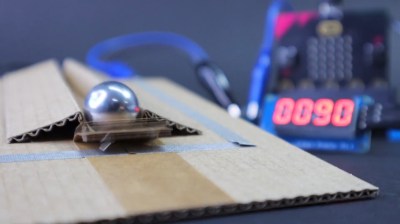We speak from experience when we say that making pinball targets is harder than you might think. The surface area of the part of the ball that touches is oh-so-small, and you really need to have gravity on your side for best results. Luckily, [TechnoChic] did the work for us and came up with these three versatile sensor designs that would be good for any game, not just pinball. They all use fresh, pristine cardboard from the Bezos Barn and a conductive fabric tape made by Brown Dog Gadgets  that they call maker tape.
that they call maker tape.
With the possible exception of not being solderable (can you solder it? ours hasn’t showed up yet), maker tape is seemingly superior to copper tape because it is designed to be conductive in the Z-direction, and if you’ve ever laid out a copper tape circuit, you know that tape overlaps are pretty much par for the course.
First on the list is the track switch, which we think is pretty much necessary. After all, what fun is a pinball machine without at least one pair of rails to ride? Might as well score some points at the same time. This one looks to be the trickiest since the rails have to be consistently spaced, otherwise the ball will fall. The drawbridge target uses a cardboard hinge and the weight of the ball to force two pieces of tape together to complete the circuit.
The flappy hole target is probably our favorite because it’s the most adaptable. You could use it for all kinds of things, like getting the ball to a basement level of a pinball game, or if you want to be evil, set it up in the drain area and deduct points every time you lose the ball, or just use it to trigger the next ball to drop. This one would also be really good for something like Skee-Ball and would really keep the BoM cost down compared to say, IR break-beam targets or coin slot switches.
You can check out these sensors in a brief demo after the break, and then see how [TechnoChic] put these ideas to use in this winter-themed pinball machine we showed you a few weeks ago.
















Not meaning to be overly critical, but wouldn’t the copper foil tape used in Tiffany-style stained glass work just as well? And, yes, it’s solderable.
Oxidation?
An IR gate switch costs pennies. Split a photo interrupter or shine an LED onto a phototransistor or CdS cell plus a comparator.
Whoops, I meant to post this top level, not as a reply. Silly comment system.
IR Reflective sensor. :)
https://www.amazon.com/reflective-sensor/s?k=reflective+sensor
Bare copper tape is solderable, and conductive *when clean*, but it oxidises and loses surface conductivity, and generally isn’t the best for momentary and low-pressure contacts.
The conductive mesh tape used here is better known as the stuff used in conductive gaskets on the doors of RF shielding boxes, which is plated to maintain it’s performance over time and repeated mechanical stress.
The rolling ball would polish the surface if it were used often enough.
There are other types of conductive tapes that are similarly priced.. e.g. 3M 1183 Tin-Plated Copper Foil Tape, 3M Nickel on Copper-Plated PET Ripstop Fabric Tape 2191FR or their cheaper knockoffs.
There are other ways of detecting a metal balls – capacitance sensor, magnetic reluctance -the sensor detects the change in presence or proximity of ferrous objects, optical sensor – by interruption or reflective means.
If the conductive tape isn’t solderable, you could just attach a ring terminal or solder tab to it with a mechanical fastener.
In general, conductive sensors are not desirable. Dirt and oxidation can disrupt. Optical might work pretty well, the balls are usually fairly reflective and signal could be encoded to allow rejection of stray light. Magnetic reluctance is probably the most reliable way to go but may disrupt the momentum of the ball. Though, with the right tuning, it might be very small.
Or just use what pinball machines use. Lever actuated microswitches.
Great vid ! Gave me some ideas for a kids game. One thing was missing from the short video…. the pinball sound of Bing Bing Bing Bing Bing (with the chunking of the mechanical counters – yeah old school here). 😁
Pinball arcade owner weighing in. The comments suggesting IR beams or micro switches are spot on. There are other touchless sensors used in commercial games but I’m not sure if they’re taking advantage of the Hall effect or capacitance changes as the ball passes over. Anything based on conductivity is doomed to have reliability issues. Not to take away from this guy’s fun experiments. I hope there’s more in the future.
This triggered some childhood memories! I found a good size ball bearing and it rolled nicely on rails made of Lego. I had a Lego motor and so created a gate that stopped the ball bearing, but then retracted because the bricks either side were wrapped in kitchen foil and it completed a circuit to the motor. Whatever the merits here, I know some fun was being had!